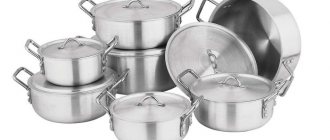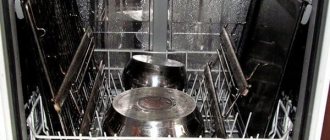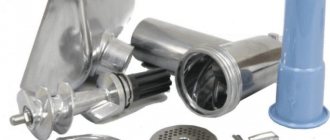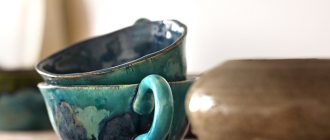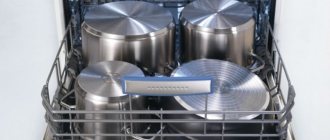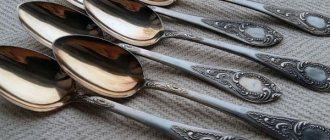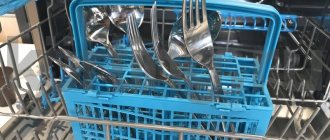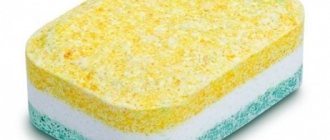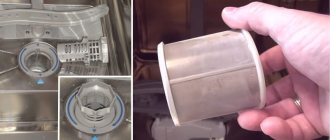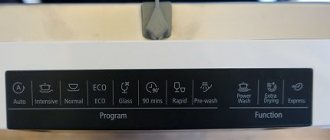The presence of a dishwasher in the house is not an indicator of luxury, but only confirms the desire of people to keep up with the times and technology. Such a device performs an important task, depriving owners of the need to wash dishes by hand. But before buying a system, you need to understand what cannot be washed in the dishwasher and how to care for it.
Knives and tools with sharp edges
Sharp objects are contraindicated in the dishwasher.
Firstly, you can forget or simply not know about cutting objects, if you were not the one who put the dirty dishes, and get seriously injured. Secondly, such washing can ruin good appliances. Strong detergents, when used frequently, will dull the sharp edges of expensive knives over time. This is especially true for ordinary housewives who are not often puzzled by sharpening. Knife handles can be damaged in the dishwasher, and carbon steel blades can rust over time.
Thirdly, carelessly placed knives can simply damage the parts of the dishwasher, which will lead to breakdown.
All this, of course, does not apply to ordinary table knives, but their steel inevitably becomes dull over time due to frequent washing.
What can be washed in PMM under certain conditions
Some cutlery can be washed by choosing the right temperature and a suitable product:
- Teflon frying pans, saucepans. The original Teflon brand favors automated care. Incompetent sellers pass off any non-stick coating as Teflon. Therefore, before loading your favorite frying pan, read the instructions and study the markings. Symbols on the dishes help determine the correct use, care, and storage.
- Knives. If the model is equipped with a special compartment for knives, you can wash it without problems, otherwise the sharp blades will damage the basket, become dull, and the wooden handles will become deformed.
- Baking trays - it is advisable to load them into the lower section, suitable in size. First remove burnt food debris and grease so as not to clog the pump and filters.
- Filter jug. Jug “Barrier”, “Aquaphor”, and other brands refresh at a temperature of about 40 degrees, preferably without drying.
- Hood filter - the filter grille is not made of aluminum alloy.
Utensils made from unsuitable metal
The only metal that is 100% dishwasher safe is stainless steel. It is difficult to damage and will not rust.
Cookware made of cast iron or carbon steel quickly rusts from water. That is why it is recommended not to wash cast iron cauldrons and frying pans at all, but simply wipe them thoroughly with a cloth. Enameled cookware can be washed in the dishwasher, but over time this can also damage the enamel.
Don't put aluminum cookware in the dishwasher: it will become dull and blackened, with dull white dry spots. Aluminum is one of the softest and most “responsive” metals; it reacts not only with alkalis and acids, but also with water. To prevent this, manufacturers coat it with a protective oxide layer. But dishwasher detergents contain phosphates, which can destroy the coating. This does not make the food harmful, and the dishes can be used, but they will look unsightly and will last less.
Metals that are prone to tarnishing (copper and brass) are also best not used in the dishwasher. At a minimum, they will lose their shine when exposed to harsh detergents.
Do not put non-stick pans in the dishwasher. Residues of food can be easily removed from such a surface with a regular damp sponge, and the non-stick layer can be easily damaged in a machine.
There are no markings on the container
It's rare, but sometimes plastic utensils really don't have any markings. You will have to act, evaluating the material yourself. Thick, elastic, durable plastic will probably easily withstand automatic washing. As a rule, they are made from such material:
- plastic containers for microwaves;
- Bakeware;
- ice trays;
- pencil holders;
- baskets for laundry, powder, etc.;
- glasses for toothbrushes;
- soap dishes;
- flower pots;
- hard plastic toys (Lego);
- various filters.
If you are not sure whether the plastic will withstand washing, try setting the delicate mode and placing the item in the PMM as high as possible, away from the heater. If you have a lot of plastic items and they are small, it is better to put them in a laundry bag for washing to prevent spillage.
Important! Washing disposable tableware, as well as plastic packaging for cakes, etc., in the PMM is strictly prohibited.
Very delicate products
Fragile and fragile dishes made of crystal and porcelain, ceramics and glass can crack and break under the pressure of water during washing in the machine.
Some PMMs have a delicate mode designed specifically for such products.
We’ll look at how not to ruin expensive dishes further.
Crystal objects
It is advisable to wash crystal in the dishwasher separately from other dishes, using a special mode for washing crystal, using gentle detergents and rinse aid for shine.
But nevertheless, this does not guarantee that crystal glasses or vases will remain safe and sound and will not lose their original appearance. Therefore, it is better to wash them by hand.
Porcelain
If there is no special image on the porcelain dishes that allows washing in a machine, then it is better to abandon this idea.
Not only can fragile porcelain crack under the influence of high temperatures of water and steam, but also the design and decorative elements that decorate porcelain products can be washed away irrevocably.
The patterns and gilding on the rim of the mugs and saucers are not stable under the influence of detergents (such as “Fairy”), so the dishes will lose their decent appearance after the first cycle in the PMM.
Ceramic tableware
In most cases, the manufacturer allows ceramics to be cleaned in the dishwasher, but do not forget about the printed images. If the dishes are decorated, they are automatically considered suitable for hand washing only.
Clay dishes
Pots and molds made of clay, but covered with glaze, are prohibited from being placed in the dishwasher.
The porous structure of the material will lose its strength during prolonged exposure to hot water, steam and chemicals and will soon crack.
What is not prohibited is permitted
The list of taboos turned out to be impressive and it may seem that only “select” dishes are suitable for the dishwasher. But in reality this is not the case; the list of permitted utensils is large:
- Any stainless steel products.
- Pots, bowls, frying pans, cans with enamel coating. The condition is that there should be no cracks or chips, and the utensils should only be placed in the lower basket.
- Ceramic pots, cups, ducklings, roasting pans with glaze.
- Containers, containers, bottles, cutting boards made of heat-resistant plastic.
- Coated cast iron cookware. Manufacturers almost always put markings on such products.
- Utensils are made of heat-resistant glass; washing dishes from ordinary glass is allowed, but provided that the items are carefully secured with special holders, as well as a gentle washing program is turned on.
- Bottles, nipples, baking molds made of silicone. Well-known manufacturers of such products must mark the products, allowing them to be placed in the PMM.
On a note! The machine perfectly cleans children's toys made of silicone, heat-resistant plastic, and stainless steel from dirt.
If in any doubt, do not put dishes and household appliances at risk, but immediately wash kitchen utensils by hand. It is better to load items into the PMM that are included in the list of permitted items.
To facilitate a routine and labor-intensive procedure, a dishwasher was invented. Housewives can only follow the recommendations and observe the rules for operating household appliances. We hope that the information on prohibitions and permits will be useful.
What are homemade dishwasher substitutes made of?
The key components are surfactants that easily break down fat. All other components are aimed at enhancing the splitting effect, extinguishing foam, aromatization, uniform dissolution and preservation. Special products may contain acids, bleach, sodium silicate, which resists corrosion, brighteners, enzymes, thickeners and much more.
Knowing the composition, you can independently prepare a mixture for washing dishes in PMM. For what? It is possible to adjust the percentage of components, achieving maximum harmlessness. Homemade preparations are prepared based on:
- Soap;
- Citric acid;
- Boers;
- Lye;
- Mustards.
Recommendations for choosing a mode
It is necessary to select the operating mode of the washing machine taking into account the condition of the loaded dishes and the material from which they are made. Usually the standard functions of the unit are adhered to.
Increase the washing intensity if a large percentage of the dishes are heavily soiled or have layers of grease on the surface.
For dishes made of thin glass and porcelain, the delicate mode is suitable.
Express mode is needed for dishes that only need to be washed with cold water. The hot rinsing mode is chosen when preparing sets for the festive table. It is needed to warm up plates so that the food served on them does not get cold quickly.
Wooden utensils and cutting boards
Wooden plates, spoons, cutting boards, and any utensils with wooden handles are absolutely not suitable for the dishwasher.
When the PMM operates, under the influence of heated water and hot steam, the wood swells, and after drying it loses its shape and cracks. Wooden products become unusable after just a few washes.
Do not forget that wood absorbs chemicals well, so it can acquire an unpleasant odor and become dangerous for use.
Plastic dishes
Before you open the machine and load plastic utensils into it, you should read the symbols on the back.
Only heat-resistant food-grade plastic, which has a special symbol on it, can be washed in a PMM. The crossed out symbol strictly prohibits washing in the dishwasher, just like the symbol “PS” (polystyrene product) or “PVC” (PVC). When heated, these substances turn into harmful compounds and are toxic to humans.
Only items made of food-grade polypropylene with the “PP” symbol, as well as items made of polyethylene terephthalate “PET,” can be washed in the dishwasher.
Disposable plastic cups, cutlery, and food containers should never be washed in the dishwasher. Such dishes should be thrown away after one use.
Can regular detergents be used in the dishwasher?
One of the common mistakes that happy owners of dishwashers make is using standard detergents. What does this mean? Products used for manual dishwashing produce a large amount of foam, which is harmful to the dishwasher. Because of this, the service life is reduced and some parts quickly fail.
There are special powders and tablets for dishwashers. Moreover, the first ones are used if the dishes are not too dirty. The tablets take longer to dissolve, so they are used when large quantities of heavily soiled dishes are loaded into the dishwasher.
For effective washing, there are rinse aids. They remove detergent residues as well as germs and bacteria.
To extend the service life, use descaling agents once every six months, and a degreaser once a month - it removes accumulated grease from the walls and internal parts of the machine
Plaque removal
City apartments sometimes have hard water. Therefore, the relevant question is how to wash crystal so that it shines. After all, it is known that various salts impart hardness to water, and they, in turn, contribute to the formation of plaque.
Acids will come to the rescue. You can use a solution of lemon, oxalic or vinegar. You should not try to make the concentration too high.
Experienced housewives give interesting advice on how to get rid of the plaque that inevitably appears in crystal vases. For this you can use a natural abrasive. A handful of rice, peas or even potato peelings is placed in the container. Next, you need to shake it vigorously.
With this procedure, impurities are removed. Then the vase should be washed with a glass cleaner, wiped dry and set to dry completely.
Non-standard cleaning products
If limescale has accumulated in the vases, and the wine glasses are stained by red wine, then this problem can be easily solved with carbonated drinks. You just need to pour any liquid with carbon dioxide into the dishes and leave for several hours.
After this, the items should be cleaned with a sponge and dried. There will be no trace left of the plaque, and the crystal will regain its original shine.
Salad bowls suffer from a greasy coating. To combat it, use a glass cleaner. It is necessary to thoroughly treat the dishes and wrap them in a soft cloth. Thus, the salad bowls should sit for a couple of hours. After this, they will be easy to wash until shiny.
Using baking soda to clean crystal is not recommended. However, for a vase that has acquired a green tint during use, the following method is suitable. It is necessary to dilute a teaspoon in a liter of warm water and rinse the walls of the product with this solution. After this, the vase should be treated with a solution of ammonia in a ratio of 1:3.
Features of PMM operation
Engineers have introduced special programs according to which household appliances operate. By using hot water (plus 50-75 degrees Celsius), high temperature modes, detergents (concentrates, salt, rinse aids), housewives get shiny plates, cups, cutlery and other kitchen utensils.
A variety of materials are used to make dishes, and not all of them are able to withstand such severe “tests.” For the convenience of consumers, dishware manufacturers provide their products with special markings, which make it easy to understand whether or not the product is suitable for washing in PMM.
How to position
The quality of washing household items and dishes depends on their correct location in the PMM:
- Start loading from the bottom of the working compartment. The water temperature here is higher than at the top.
- Glassware is placed upside down.
- Large plates are placed on the sides, and small ones in the center.
- Cutlery with long handles is folded horizontally, alternating with other items.
- The pans are placed vertically so that the handle rests on one of the plates.
- Baking trays are placed along the edge of the basket at the bottom.
See also
Methods and rules for cleaning a toaster inside and outside at home
Remains of food must be removed from plates, trays, and pots before washing. If there is a lot of dirt, then it is better to fill the car halfway.
Answers on questions
Having collected all the readers’ questions related to the topic, we answered in detail the most interesting and relevant ones.
Question: Can Teflon frying pans be washed in the dishwasher?
Answer: The non-stick properties of Teflon frying pans may be impaired after 2-3 washes in PMM. Studying the forums of housewives, we came to the conclusion that some have been calmly washing such dishes in a machine for years, while others complain that they have already “killed” several frying pans, despite the permission sign. It's a matter of the quality of the frying pan and the aggressiveness of the detergents.
Question: Can the electric kettle be washed?
Answer: Yes, manually. To avoid damaging the electrical appliance, rinse the kettle with warm water under the tap.
Question: Can a Barrier or Aquaphor jug be machine washed?
Answer: Yes. Select a temperature cycle for washing the jug up to 40 degrees.
Question: I want to wash the steamer without using my hands. Will it spoil?
Answer: Depends on the material of the steamer. An aluminum container will deteriorate, but a plastic steamer has no contraindications.
Question: I was planning to sterilize jars in the dishwasher. Never tried. What mode should I set?
Answer: If there is no “can sterilization” function (in some Bosch models), select a temperature setting of at least 60 degrees.
We hope that our tips will be useful to you. Happy washing experiments.
Restrictions on other cookware
But thin plastic, cut-out wood kitchen utensils and aluminum do not limit the limitations of automatic washing. What other types of dishes should not go into the dishwasher? Machine models with a limited set of programs require special attention in relation to:
- Things made of fine porcelain. Although any porcelain has no place in the dishwasher, delicate ones will be especially sad when they crack from hot water. And the included turbo dryer will become a funeral requiem for him.
- Cast iron frying pans, casserole dishes and other ferrous metal products. Of course, an automatic wash alone won’t be able to finish them off, especially large items. But the second or third attempt will definitely lead to corrosion spots. And it will immediately become clear why it is better to wash such heavy objects by hand.
- Crystal and souvenirs. Their fragile beauty was not created for automatic car washes, so the fateful date may not be tolerated. Crystal has a bad habit of cracking due to temperature changes. Or in the process it will become covered with micro-scratches and come out completely damaged.
- Vessels with vacuum lids. Such food containers, saucepans and mugs with lids that can pump out air so that a vacuum is formed inside to preserve food, should not end up in the dishwasher, even by accident. In an automatic machine they undergo a certain deformation. It may be invisible to the naked eye, but the seal is lost and air begins to leak under the covers.
- Sharpened kitchen knives. The general rule for caring for such items is that knives are quickly rinsed with cool water under running water. Then they don't become dull. Hot water affects the sharpness, and 5-7 minutes is enough for this. With constant contact with hot water, knives will have to be sharpened every other day, which will very quickly lead to abrasion of the blades. It is clear that prolonged rinsing in hot water in the dishwasher is contraindicated for a sharp knife. And the same applies to scissors and other sharp objects that you want to wash automatically.
- Copper products also do not like high water temperatures. And upon contact with harsh detergents, they will simply turn green, oxidizing and losing their former appearance.
- Thermoses and thermal mugs. Usually they are washed only by hand. An exception may be thermal containers, which the manufacturers themselves declare as being able to withstand automated washing without damaging the heat-insulating layers. Still, it’s better not to risk that the temperature of your favorite drinks will not remain as long as before.
In reality, this list can easily be expanded to include dishes with drawings printed on them, souvenir cups and mugs with photo printing, and other representatives of the tableware tribe, which can easily lose their colorfulness. If you know how dishwashing equipment works, you can avoid such mistakes.
What's going on inside
All dishwashers operate according to a specific program. By pressing the button you can enable:
- water supply through a pump;
- heating it;
- washing under rotating jets of water;
- rinsing with a special composition.
Washed dishes are also dried inside. In one step, the unit can clean up to 14 sets of dishes.
Detergents
There is a container for detergent on the door of the household appliance. It is impossible to remove stains without using a powder or tablet. And the machine is configured to work with detergents. Without them, the device may automatically turn off. Each type of dishwasher has its own product.
At the bottom of the device there is space for regenerating sodium salt. It will help soften tap water and clean cutlery.
It is better to purchase tablets that contain a saline solution and rinse aid along with the detergent.
Water temperature
On the electronic control unit, sensors control the temperature of the water inside. A special meter supports the operating mode of the unit. In addition, the sensor ensures that the heating element does not overheat. Optimally, water is heated to 50-60 degrees. Sensors also determine the hardness of the water, the presence of impurities in it, and even the air temperature in the kitchen.
Prolonged exposure to moisture
You can clean dishes until they shine only in several stages:
- First, soak the items so that dried dirt can be washed off.
- The cutlery is thoroughly washed with jets of hot water, which is supplied through the spray nozzles.
- At the end, rinsing with clean water and drying occurs.
The duration of action of water depends on the selected operating mode of the machine and the composition of the soil on the dishes.
Hot air drying
The machine dries items using a built-in fan. Although they note that this method of processing washed dishes is energy dependent, it proceeds quickly. More modern models are equipped with the mineral zeolite, which releases dry heated air when absorbing water. This air flow serves to dry wet glasses and plates.
Basic operating rules
You need to use your dishwasher wisely so that expensive equipment lasts a long time. Therefore it is necessary:
- load the unit tank with moderately contaminated items without food residues;
- make sure that the drain filter is not clogged;
- periodically wash the machine, including when it is unloaded;
- wipe dry the inside of the unit or wipe them with a soft cloth soaked in warm water;
- Sprayers should be washed under warm running water.
To remove the unpleasant odor inside the Redmond car, use deodorant.

